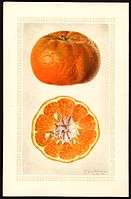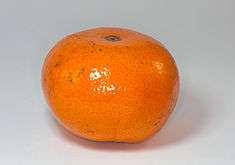Tangerine
| Tangerine | |
|---|---|
 | |
| Scientific classification | |
| Kingdom: | Plantae |
| (unranked): | Angiosperms |
| (unranked): | Eudicots |
| (unranked): | Rosids |
| Order: | Sapindales |
| Family: | Rutaceae |
| Genus: | Citrus |
| Species: | C. tangerina |
| Binomial name | |
| Citrus tangerina Tanaka | |
The tangerine (Citrus tangerina)[1] is an orange-colored citrus fruit that is closely related to, or possibly a type of, mandarin orange (Citrus reticulata).
The name was first used for fruit coming from Tangier, Morocco, described as a mandarin variety.[2] Under the Tanaka classification system, Citrus tangerina is considered a separate species. Under the Swingle system, tangerines are considered to be a group of mandarin (C. reticulata) varieties.[3] While tangerines genetically resemble mandarins,[3] the genetics are still not thoroughly studied.[4][5][6] The term is currently applied to any reddish-orange mandarin (and, in some jurisdictions, mandarin-like hybrids, including some tangors[7][8]), but the term "tangerine" may yet acquire a definite genetic meaning.
Tangerines are smaller and less rounded than common oranges. The taste is considered less sour, as well as sweeter and stronger, than that of an orange.[9] A ripe tangerine is firm to slightly soft, heavy for its size, and pebbly-skinned with no deep grooves, as well as orange in color. The peel is very thin, with very little bitter white mesocarp,[10] which makes them usually easier to peel and to split into segments. All of these traits are shared by mandarins generally.
Peak tangerine season lasts from autumn to spring. Tangerines are most commonly peeled and eaten out of hand. The fresh fruit is also used in salads, desserts and main dishes. The peel is used fresh or dried as a spice or zest for baking and drinks, and eaten coated in chocolate. Fresh tangerine juice and frozen juice concentrate are commonly available in the United States. The number of seeds in each segment (carpel) varies greatly.
Nomenclature and varieties
Moragne "tangierines" were grown at Palatka by a Major Atway. Major Atway was said to have imported them from Morocco (capital Tangiers), which was the origin of the name "tangerine". Major Atway sold his groves to N. H. Moragne in 1843, giving the Moragne tangerine the other part of its name.[11]
The Moragne tangerine produced a seedling which became of one of the oldest and most popular American varieties, the Dancy tangerine (zipper-skin tangerine, kid-glove orange).[11] The Dancy is no longer widely commercially grown; it is too delicate to handle and ship well, it is susceptible to Alternaria fungus, and it bears more heavily in alternate years.[12][13] Dancys are still grown for personal consumption, and many hybrids of the Dancy are grown commercially.
Both these cultivars may be pure mandarins, unlike many cultivars, which are hybrids.[14]
Until the 1970s, the Dancy was the most widely grown tangerine in the US;[15] the popularity of the fruit led to the term "tangerine" being broadly applied as a marketing name.
Florida classifies tangerine-like hybrid fruits as tangerines for the purposes of sale and regulation;[7] this classification is widely used but regarded as technically inaccurate in the industry.[8] Among the most important tangerine hybrids of Florida are murcotts, a late-fruiting type of tangor marketed as "honey tangerine"[16] and Sunbursts (an early-fruiting complex tangerine-orange-grapefruit hybrid).[17] The fallglo, also a three-way hybrid (5/8 tangerine, 1/4 orange and 1/8 grapefruit) is also grown.[18]
-

A tangerine
-

A botanical illustration of a Manurco tangerine, painted by Royal Charles Steadman in January, 1926.
Nutrition
|
A Murcott, likely a tangerine hybrid | |
| Nutritional value per 100 g (3.5 oz) | |
|---|---|
| Energy | 223 kJ (53 kcal) |
|
13.34 g | |
| Sugars | 10.58 g |
| Dietary fiber | 1.8 g |
|
0.31 g | |
|
0.81 g | |
| Vitamins | |
| Vitamin A equiv. |
(4%) 34 μg (1%) 155 μg |
| Thiamine (B1) |
(5%) 0.058 mg |
| Riboflavin (B2) |
(3%) 0.036 mg |
| Niacin (B3) |
(3%) 0.376 mg |
| Pantothenic acid (B5) |
(4%) 0.216 mg |
| Vitamin B6 |
(6%) 0.078 mg |
| Folate (B9) |
(4%) 16 μg |
| Choline |
(2%) 10.2 mg |
| Vitamin C |
(32%) 26.7 mg |
| Vitamin E |
(1%) 0.2 mg |
| Minerals | |
| Calcium |
(4%) 37 mg |
| Iron |
(1%) 0.15 mg |
| Magnesium |
(3%) 12 mg |
| Manganese |
(2%) 0.039 mg |
| Phosphorus |
(3%) 20 mg |
| Potassium |
(4%) 166 mg |
| Sodium |
(0%) 2 mg |
| Zinc |
(1%) 0.07 mg |
|
| |
| |
|
Percentages are roughly approximated using US recommendations for adults. Source: USDA Nutrient Database | |
Tangerines are a good source of vitamin C, folate, and beta-carotene. They also contain some potassium; magnesium; vitamins B1, B2, and B3; and the compounds lutein and zeaxanthin.[19] Tangerine oil, like all citrus oils, has limonene as its major constituent, but also alpha-pinene, myrcene, gamma-terpinene, citronellal, linalool, neral, neryl acetate, geranyl acetate, geraniol, thymol, and carvone.
Origin of the name
According to the Oxford English Dictionary, the word "tangerine" was originally an adjective meaning "Of or pertaining to, or native of Tangier, a seaport in Morocco, on the Strait of Gibraltar" and "a native of Tangier." The OED cites this usage from Addison's The Tatler in 1710 with similar uses from the 1800s. The adjective was applied to the fruit, once known scientifically as "Citrus nobilis var. tangeriana" which grew in the region of Tangiers. This usage appears in the 1800s. See the Oxford English Dictionary, 2nd edition, 1989. This fruit is referred to as Kamala kaya in Telugu and Portugal through the Caribbean. In Australia the fruit is known as a Mandarin.
References
- ↑ "Citrus tangerina Yu.Tanaka — The Plant List". theplantlist.org.
- ↑ "Home : Oxford English Dictionary". oed.com.
- 1 2 "New universal mitochondrial PCR markers reveal new information on maternal citrus phylogeny". Tree Genetics. 7: 49–61. doi:10.1007/s11295-010-0314-x.
- ↑ "Synonyms of C. reticulata at The Plant List".
- ↑ A.H. Krezdorn; Jules Janick. "Classification of Citrus" (PDF).
- ↑ Tshering Penjor; Masashi Yamamoto; Miki Uehara; Manami Ide; Natsumi Matsumoto; Ryoji Matsumoto; Yukio Nagano (2013-04-25). "Phylogenetic Relationships of Citrus and Its Relatives Based on matK Gene Sequences". PLoS ONE. 8: e62574. doi:10.1371/journal.pone.0062574.
- 1 2 Commernet, 2011. "20-13.0061. Sunburst Tangerines; Classification and Standards, 20-13. Market Classification, Maturity Standards And Processing Or Packing Restrictions For Hybrids, D20. Departmental, 20. Department of Citrus, Florida Administrative Code". State of Florida. Retrieved 14 May 2015.
- 1 2 Larry K. Jackson & Stephen H. Futch. "HS178/CH073: Robinson Tangerine". Retrieved 14 May 2015.
- ↑ Pittman & Davis (1999-02-22). "Pittman & Davis – Premium Citrus Fruit Gifts – Why Are Tangerines So Tangy?". Pittmandavis.com. Retrieved 2012-11-17.
- ↑ David Karp (2011-01-28). "Market Watch: The wild and elusive Dancy". LA Times. Retrieved 2015-07-19.
- 1 2 http://www.citrusvariety.ucr.edu/citrus/dancy.html
- ↑ Larry K. Jackson & Stephen H. Futch. "HS169/CH074: Dancy Tangerine". ufl.edu.
- ↑ "Satsuma cultivars: The best and the worst". AL.com. Retrieved 14 May 2015.
- ↑ "Assessing genetic diversity and population structure in a citrus germplasm collection utilizing simple sequence repeat markers (SSRs)". Theoretical and Applied Genetics. 112: 1519–1531. doi:10.1007/s00122-006-0255-9.
- ↑ http://www.slowfoodusa.org/ark-item/dancy-tangerine
- ↑ "HS174/CH078: Murcott (Honey Tangerine)". Edis.ifas.ufl.edu. Retrieved 2012-11-17.
- ↑ "HS168/CH079: Sunburst Tangerine". Edis.ifas.ufl.edu. Retrieved 2012-11-17.
- ↑ Larry K. Jackson & Stephen H. Futch. "HS173/CH075: Fallglo Tangerine". Retrieved 14 May 2015.
- ↑ Susanna Lyle (20 March 2006). Fruit & nuts: a comprehensive guide to the cultivation, uses and health benefits of over 300 food-producing plants. Timber Press. p. 145. Retrieved 11 June 2012.
External links
 Data related to Citrus tangerina at Wikispecies
Data related to Citrus tangerina at Wikispecies Tangerine at Wikibook Cookbooks
Tangerine at Wikibook Cookbooks Media related to Tangerines at Wikimedia Commons
Media related to Tangerines at Wikimedia Commons
